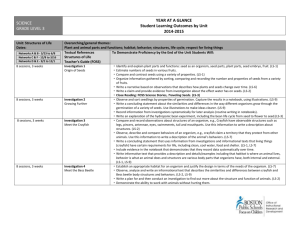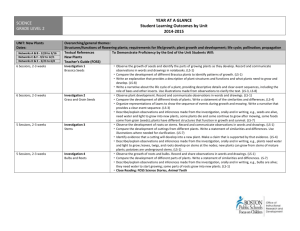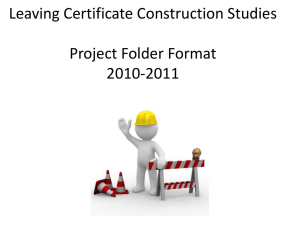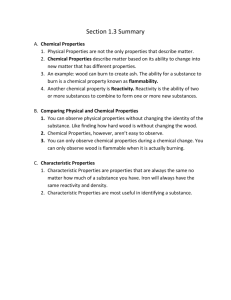SCIENCE GRADE Kindergarten YEAR AT A GLANCE Student
advertisement
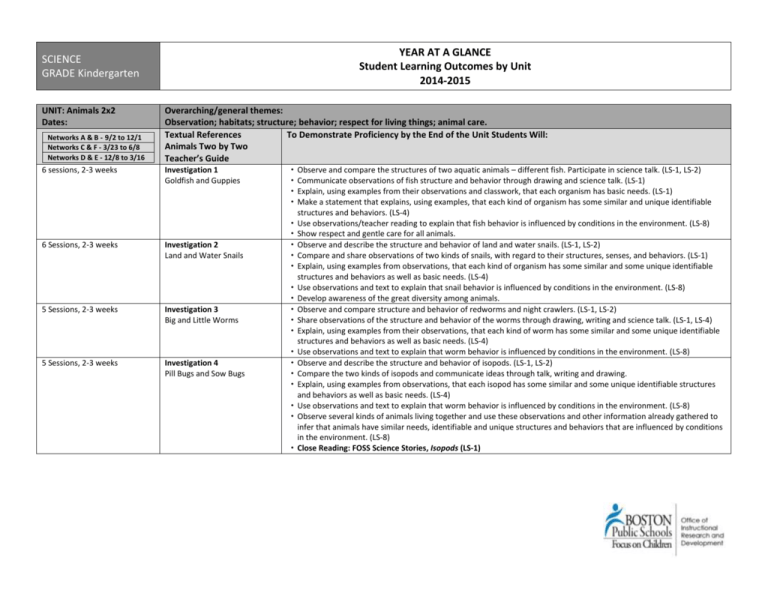
YEAR AT A GLANCE Student Learning Outcomes by Unit 2014-2015 SCIENCE GRADE Kindergarten UNIT: Animals 2x2 Dates: Networks A & B - 9/2 to 12/1 Networks C & F - 3/23 to 6/8 Networks D & E - 12/8 to 3/16 6 sessions, 2-3 weeks 6 Sessions, 2-3 weeks Overarching/general themes: Observation; habitats; structure; behavior; respect for living things; animal care. Textual References To Demonstrate Proficiency by the End of the Unit Students Will: Animals Two by Two Teacher’s Guide Investigation 1 Goldfish and Guppies Investigation 2 Land and Water Snails 5 Sessions, 2-3 weeks Investigation 3 Big and Little Worms 5 Sessions, 2-3 weeks Investigation 4 Pill Bugs and Sow Bugs Observe and compare the structures of two aquatic animals – different fish. Participate in science talk. (LS-1, LS-2) Communicate observations of fish structure and behavior through drawing and science talk. (LS-1) Explain, using examples from their observations and classwork, that each organism has basic needs. (LS-1) Make a statement that explains, using examples, that each kind of organism has some similar and unique identifiable structures and behaviors. (LS-4) Use observations/teacher reading to explain that fish behavior is influenced by conditions in the environment. (LS-8) Show respect and gentle care for all animals. Observe and describe the structure and behavior of land and water snails. (LS-1, LS-2) Compare and share observations of two kinds of snails, with regard to their structures, senses, and behaviors. (LS-1) Explain, using examples from observations, that each kind of organism has some similar and some unique identifiable structures and behaviors as well as basic needs. (LS-4) Use observations and text to explain that snail behavior is influenced by conditions in the environment. (LS-8) Develop awareness of the great diversity among animals. Observe and compare structure and behavior of redworms and night crawlers. (LS-1, LS-2) Share observations of the structure and behavior of the worms through drawing, writing and science talk. (LS-1, LS-4) Explain, using examples from their observations, that each kind of worm has some similar and some unique identifiable structures and behaviors as well as basic needs. (LS-4) Use observations and text to explain that worm behavior is influenced by conditions in the environment. (LS-8) Observe and describe the structure and behavior of isopods. (LS-1, LS-2) Compare the two kinds of isopods and communicate ideas through talk, writing and drawing. Explain, using examples from observations, that each isopod has some similar and some unique identifiable structures and behaviors as well as basic needs. (LS-4) Use observations and text to explain that worm behavior is influenced by conditions in the environment. (LS-8) Observe several kinds of animals living together and use these observations and other information already gathered to infer that animals have similar needs, identifiable and unique structures and behaviors that are influenced by conditions in the environment. (LS-8) Close Reading: FOSS Science Stories, Isopods (LS-1) YEAR AT A GLANCE Student Learning Outcomes by Unit 2014-2015 SCIENCE GRADE Kindergarten UNIT: Wood & Paper Dates: Networks A & B - 12/8 to 3/16 Networks C & F - 9/2 to 12/1 Networks D & E - 3/23 to 6/8 Overarching/general themes: Properties of materials; sorting by properties; recycle; new forms with new properties Textual References To Demonstrate Proficiency by the End of the Unit Students Will: Wood & Paper Teacher’s Guide 6 Sessions, 2-3 weeks Investigation 1 Getting to Know Wood 5 Sessions, 2-3 weeks Investigation 2 Changing Wood 5 Sessions, 2-3 weeks Investigation 3 Getting to Know Paper 3 Sessions, 1-2 weeks Investigation 4 Changing Paper 3 Sessions, 1-2 weeks Investigation 5 Constructions Observe and communicate observations about a variety of wood samples. (PS-1) Compare properties of different kinds of wood, i.e. made from different kinds of trees, used for everyday things, floats in water, some kinds sink more easily than others, absorbs water, can be processed and transformed by people. (TE-1.2) Compare properties of different kinds of wood found in the classroom. Compare how different kinds of wood interact with water. (PS-1) Sort wood samples by their properties. (PS-1) Organize results to discover which wood is harder to sink. (PS-1) Close Reading: FOSS Science Stories, Story of a Chair (TE-1.2) Observe wood samples and communicate observations through drawing, writing, and talk. (PS-1) Compare sawdust to wood shavings. (TE-1.1) Observe the transformation of sawdust into particleboard. (TE-1.2) Explore ways to change wood and relate those changes to the change in the properties of the wood sample. (sanding, soaking, gluing, laminating) (TE-1.2) Explain that some objects occur in nature and that people make others. (TE-1.1) Observe and communicate observations about a variety of kinds of paper. (PS-1, PS-2) Explain understandings and compare properties of different kinds of paper, e.g., Interactions with water, made from wood from trees, properties of paper determines its use, etc. (PS-1) Compare how different kinds of paper interact with water. Observe and compare the properties of paper before and after it has been altered, e.g., recycled, made into papiermâché, moldable when wet with wheat paste, hard when dry. (PS-1) Infer from investigations that object can be made from paper and recycling makes new products from old ones and extends the use of trees. (TE-1.2, TE-1.3) Observe and communicate how paper containers are constructed. (TE-1.3) Compare a tracing of a flat paper container to the reconstructed container and infer that they started from flat paper. (TE-1.2) Communicate knowledge of paper and wood properties to describe constructions. (TE-1.3) Make useful or artistic constructions using knowledge of the properties of wood and paper. (TE 1.3)
